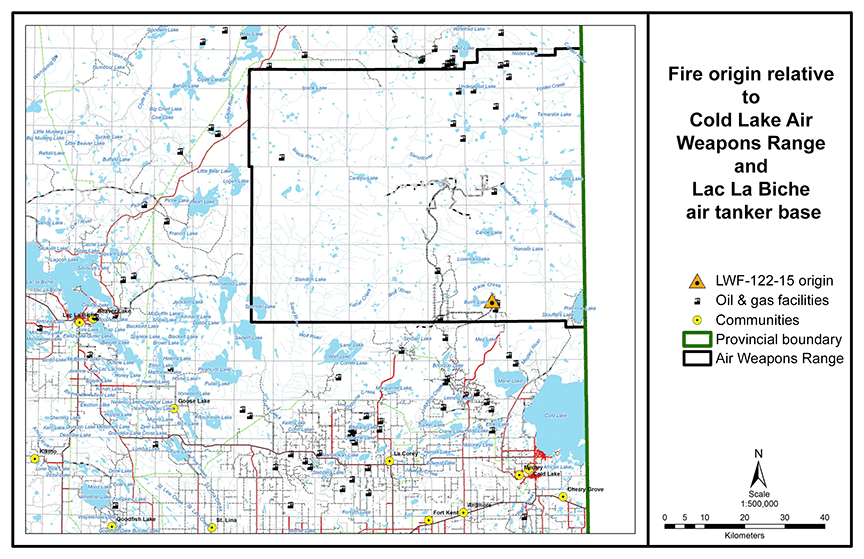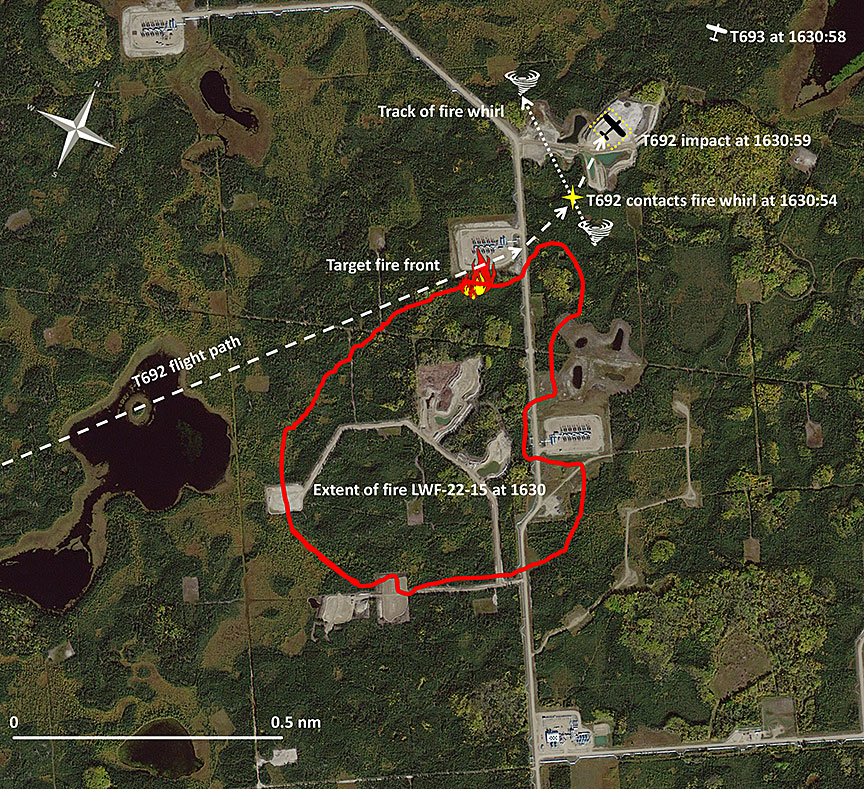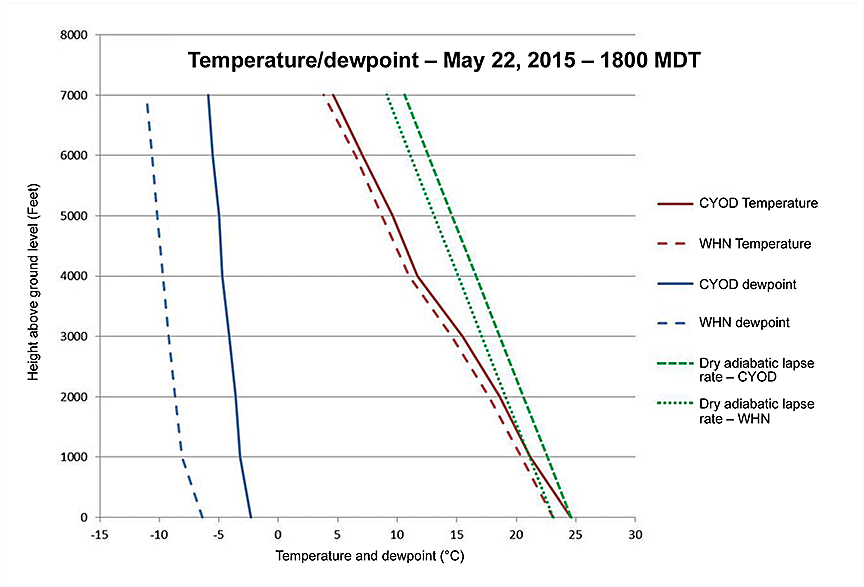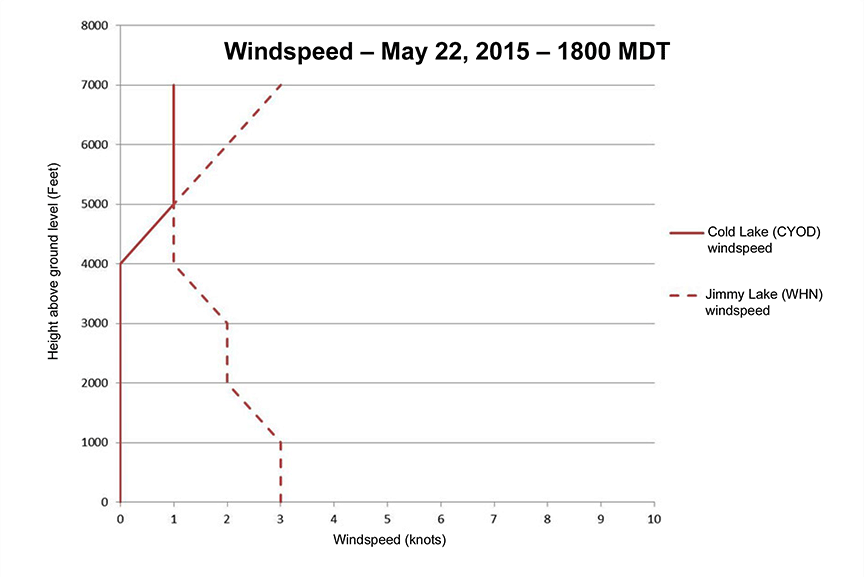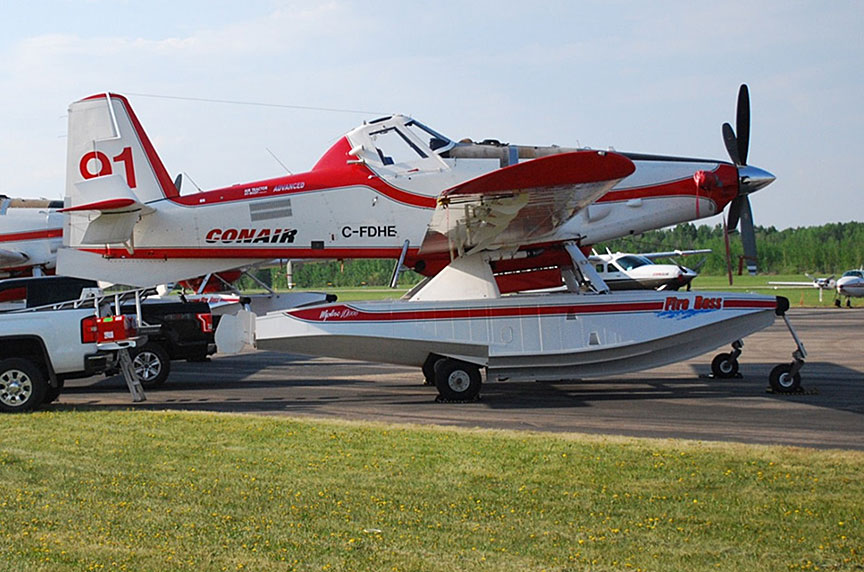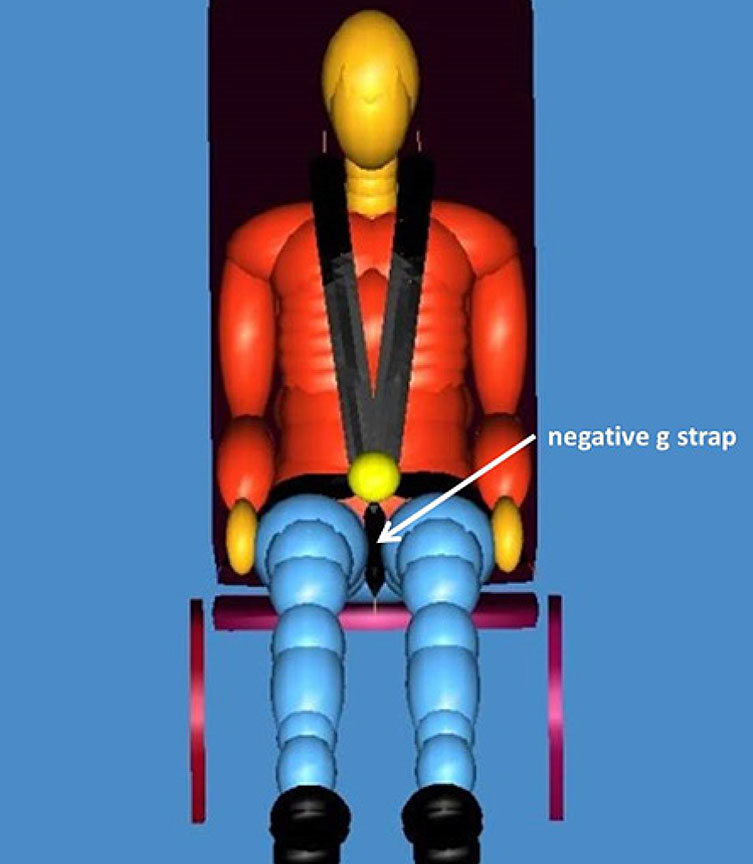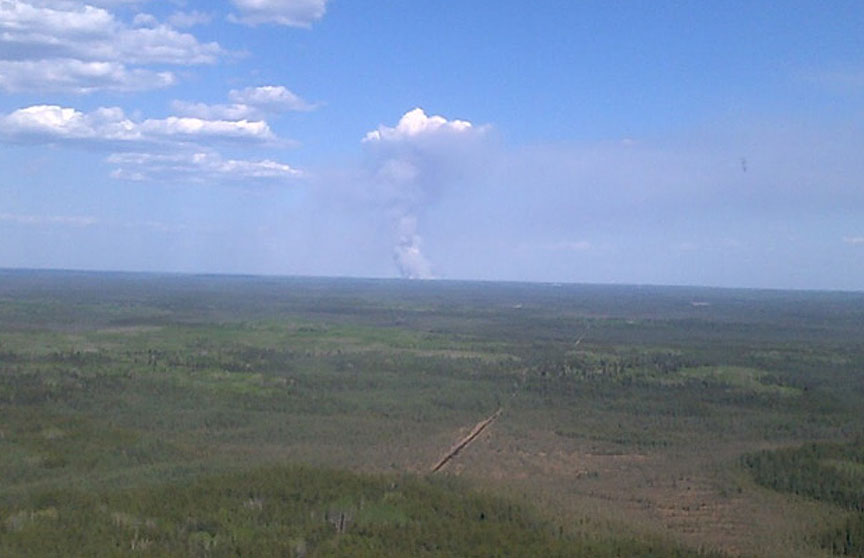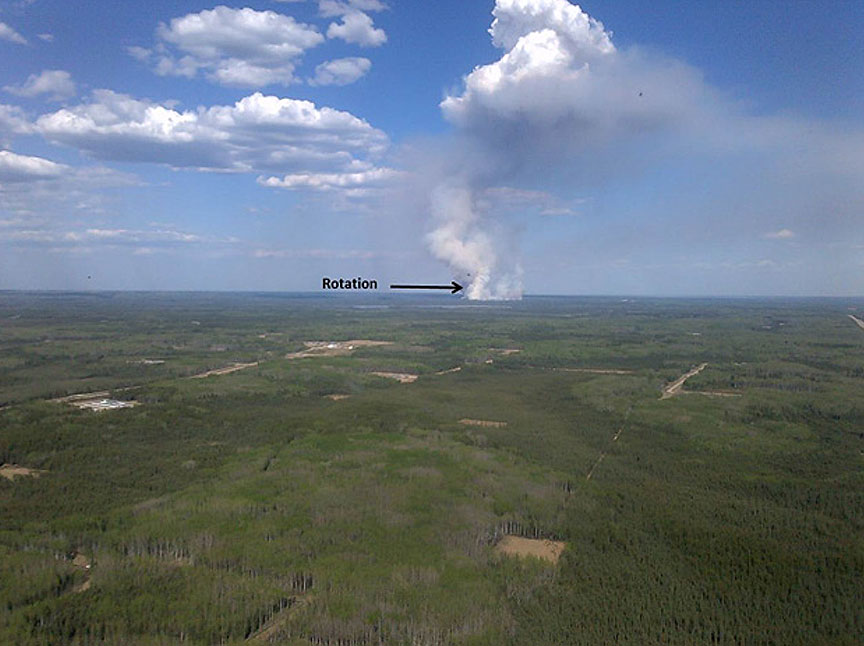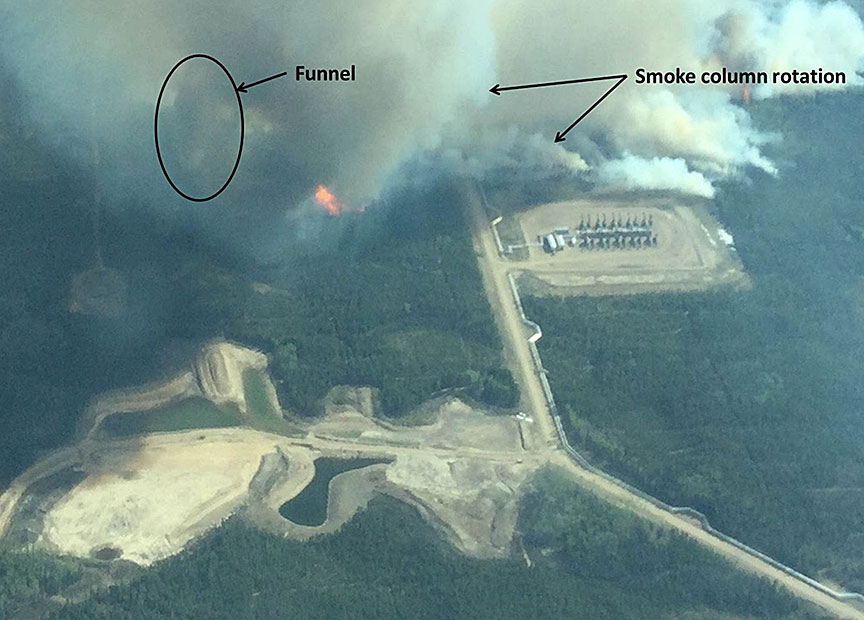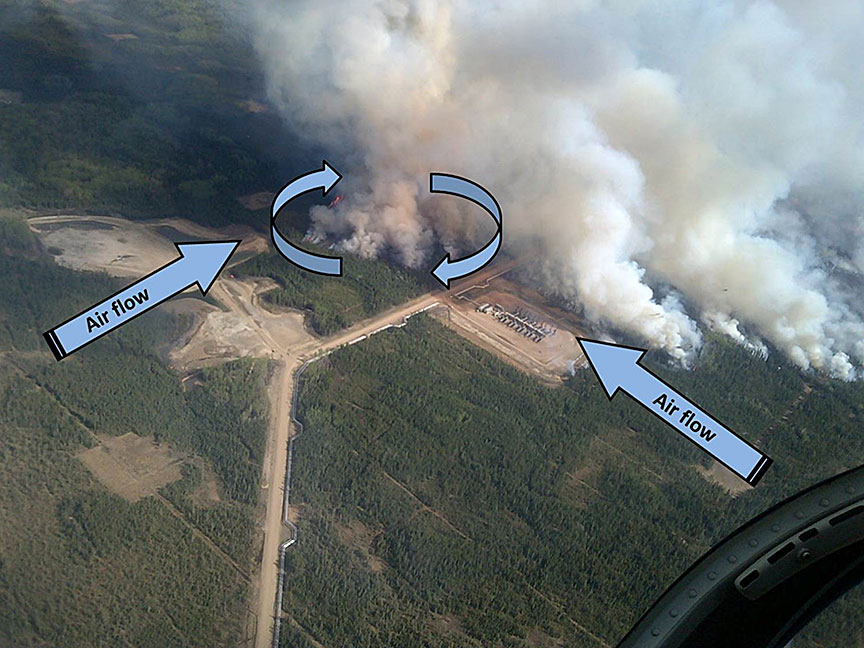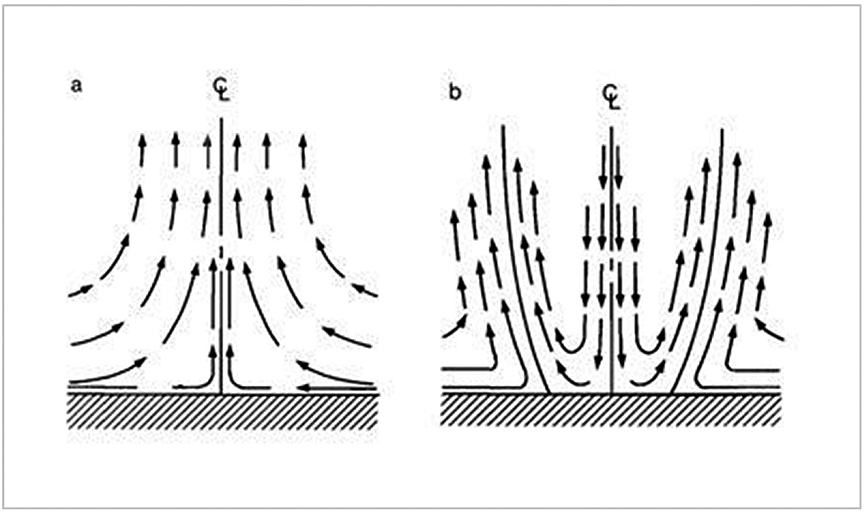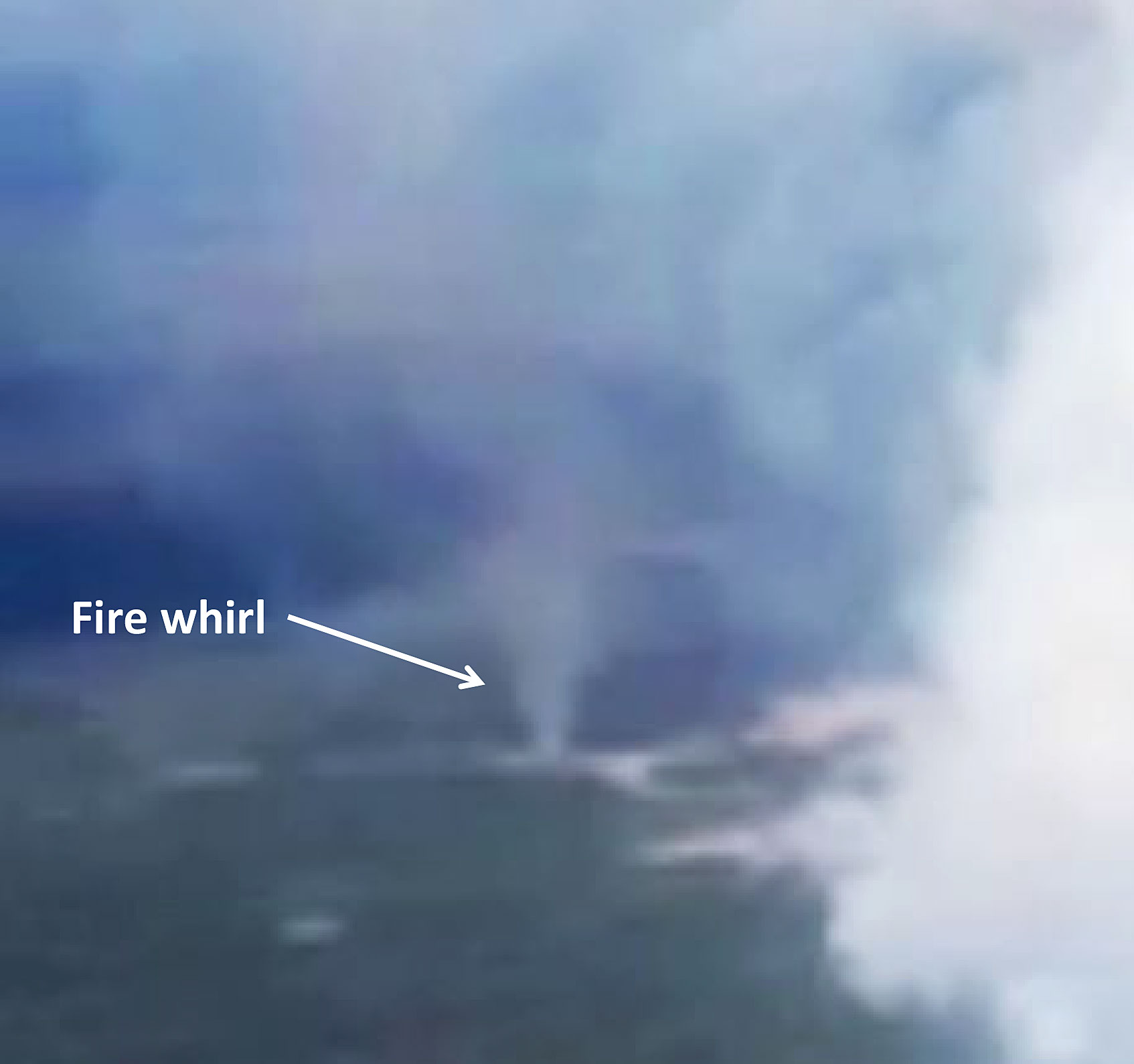Loss of control and collision with terrain
Conair Group Inc., dba Conair
Air Tractor AT-802A Fire Boss Amphibian, C-FDHV
Cold Lake, Alberta, 25 nm NW
The Transportation Safety Board of Canada (TSB) investigated this occurrence for the purpose of advancing transportation safety. It is not the function of the Board to assign fault or determine civil or criminal liability. This report is not created for use in the context of legal, disciplinary or other proceedings. See Ownership and use of content. Masculine pronouns and position titles may be used to signify all genders to comply with the Canadian Transportation Accident Investigation and Safety Board Act (S.C. 1989, c. 3).
Summary
The Conair amphibious float-equipped Air Tractor AT-802A Fire Boss, C-FDHV, serial number 802A-0348, was operating as Tanker 692 in support of wildfire management operations 25 nautical miles northwest of Cold Lake, Alberta. Tanker 692 was the last in a formation of 4 AT-802A Fire Boss aircraft followed by 2 CL-215T aircraft being operated by Conair Group Inc. Tanker 692 had completed 2 drops on the fire, from west to east, with a turnout to the north. When exiting its third drop, Tanker 692 encountered severe turbulence and then pitched to a nose-up attitude. The aircraft climbed to approximately 400–500 feet above ground level, where it rolled to the left and entered a nose-down attitude. It struck the ground right-wing low and close to nose-level at 1630 Mountain Daylight Time. The pilot was fatally injured as a result of non-survivable impact forces. There was no post-impact fire.
This report is also available in English.
Factual information
History of the flight
On 22 May 2015 at approximately 1450 Mountain Daylight Time,Footnote 1 a forest fire was reported in the Cold Lake Air Weapons Range (CLAWR). The fire was designated LWF-122-15 by the Wildfire Management Branch of the Alberta government, which then dispatched initial attack crews from the Beaver Lake Staging area and air tanker groups from the Lac La Biche tanker base. The Lac La Biche Wildfire Management Area (WMA) is one of the 10 WMAs in the province of Alberta. The CLAWR is located in this WMA, where the Wildfire Management Branch is responsible for wildfire administration and operations. Access to the CLAWR, however, is managed by the Department of National Defence (DND) to ensure that there is no conflict between civilian and military aircraft. Fire LWF-122-15 was located east of Burnt Lake near the southern border of the CLAWR, where there is also extensive oil and gas infrastructure and development (Figure 1).
The first aircraft on the scene at approximately 1537 was Bird Dog 130 (BD130), a Rockwell Turbo Commander TC-690 fixed-wing aircraft. It was joined by Tankers 204 and 202 (T204 and T202, Canadair CL-215T aircraft) and Tanker 453 (T453, Convair CV580). T453 dropped a line of retardant to the east of the fire to stop its advance. T204 and T202 were attacking the fire front under the direction of the air attack officer in BD130. T453 returned to Lac La Biche to reload with retardant, while T204 and T202 continued dropping water that they were scooping from Burnt Lake, approximately 2 nautical miles (nm) west of the fire. The fire was exhibiting extreme fire behaviour, growing rapidly and changing direction often. T204 and T202 had established a left-hand circuit, scooping from Burnt Lake and conducting drops on the fire. BD130 was established in an orbit 300–500 feet above ground level (agl) around the fire. The tankers were conducting their drops at a specified bombing height of approximately 150 to 200 feet agl. The Alberta Air Attack Fire Bombing Procedures Manual 2015 defines the specified bombing height as the height in feet agl where the tanker is to release the load. This height is generally 125 feet agl but is adjusted to account for weather, visibility, wind, and terrain conditions. After the drop, the aircraft climb back up to the circuit height of approximately 1000 feet agl.
At approximately 1615, Bird Dog 124 (BD124, Cessna 208B Caravan) arrived on scene accompanied by Tankers 680, 691, 693, and 692, 4 single-engine air tankers on amphibious floats (Air Tractor AT-802A Fire Boss). Before arriving on scene, the 4 Fire Boss aircraft had scooped a load of water from Marie Lake, approximately 11 nm to the south. BD130, as the first aircraft on scene, assumed control over these new aircraft. The 4 Fire Boss aircraft were added to the left-hand circuit from Burnt Lake with T204 and T202. The occurrence aircraft, Tanker 692 (T692, C-FDHV, serial number 802A-0348), was the last in the formation, following T693. BD124 took up a support role in a high orbit approximately 6000 feet above sea level.
T692 was approximately 15–20 seconds behind T693 as they dropped their water–foam mixture on the fire. Lateral spacing in the formation is the responsibility of the pilots and is adjusted to account for environmental and operational considerations such as visibility, wind, and wake turbulence. The formation made 2 successful drops on the northern edge of the fire next to a pad of pump jacks. On the third circuit, T680 and T691 conducted a drop on the fire and continued in the left-hand pattern with no change from the first 2 runs. T693 successfully conducted the third drop at 1630:09 and continued in the circuit. At 1630:44, T693 encountered a severe turbulence event, and the aircraft data acquisition alarm monitor (DAAM) system (see section on Data recorders) recorded a change from 4.8gFootnote 2 to −2.1g in 1.2 seconds. During this event, the pilot of T693 struck his head on the canopy structure, and the aircraft yawed left and rolled right. The DAAM data recorded that the indicated airspeed decreased to zero and then recovered. The pilot of T693 regained control of the aircraft at 1630:57.
T692 also encountered a severe turbulence event, at 1630:54, 10 seconds after T693. The aircraft DAAM system recorded a change from 4.2g to −3.2g in 1.0 second. T692 was seen to pitch to a nose-up attitude and climb to approximately 400–500 feet agl. The aircraft was then observed to roll left and enter a nose-down attitude. T692 struck the ground in a large open area (borrow pit) at 1630:59, right-wing low and close to nose-level (Figure 2). In the last 1.6 seconds before impact, the DAAM data showed a change in g force from −1.0g to 2.9g in 1.2 seconds; g force then held at 2.9g for 0.4 seconds before the data recording ceased at impact. The impact forces were not survivable. There was no post-impact fire.
Immediately after the accident, a large fire whirl was seen moving from southeast to northwest across the borrow pit west of T692. The fire whirl was approximately 50–100 feet wide at the base and extended to an altitude of approximately 1500 feet agl. It had a very strong rotation and uptake of material. The fire whirl continued across the borrow pit and re-entered the treeline, where another fire was ignited by debris it was carrying. It then disappeared from view shortly after entering the trees.
Emergency response
The airborne fire-suppression operation on fire LWF-122-15 was called off immediately after the accident. At 1633, the pilot of BD130 called Cold Lake terminal control to report that an air tanker had crashed. Because of the low altitude of BD130, the pilot had difficulty communicating with the terminal control. At 1635, BD124 also contacted terminal control to inform them that an air tanker had crashed and requested that emergency personnel be dispatched. All of the air tankers returned to Lac La Biche. BD130 and BD124 remained overhead to help coordinate the emergency response. At 1642, a civilian helicopter operating in support of the firefighting operation landed at the crash site. At 1646, a second helicopter dropped off 2 more personnel at the crash site to help the first crew. The first responders assessed that the pilot of T692 had no pulse, and they were not able to extract him from the wreckage. The aircraft's fuel tanks had ruptured on impact, covering the wreckage and the surrounding area with fuel. With the fire advancing on the crash site, the crew decided to leave the site at 1718. At 1726, all ground crews were pulled off the fire as the area was deemed unsafe. A DND Griffon helicopter, Rescue 417, from Canadian Forces Base (CFB) Cold Lake (CYOD) arrived at the crash site at 1746. The fire around the site was still active at the time. A fixed-wing medical evacuation (MEDEVAC) aircraft was put on standby back at CYOD. The crew of Rescue 417 extracted the pilot of T692 and departed the site at approximately 1845, arriving back at CYOD at 1854. The pilot was transferred to an ambulance and taken to the local hospital.
Wreckage examination
The aircraft wreckage was located in an open sand-and-gravel area referred to as a “borrow pit.” The aircraft had struck the ground right-wing low and in a nearly nose-level attitude. The right wingtip had struck the ground first and was followed by the right float and then the left float. The float structure had collapsed and remained mainly under the aircraft. The aircraft had travelled approximately 80 feet from the first ground scars.
All of the aircraft's components were found and identified within a 90-foot radius of the fuselage, and all main components were still attached to the aircraft. The fuselage and wings had substantial impact damage. All of the fuel and foam tanks had ruptured, contaminating the surrounding ground.
The investigation determined that there was flight control continuity before the accident. By measuring the threads on the flap actuator, it was estimated that the flaps were set to approximately 13°. This is consistent with the flap setting when exiting a water drop. The throttle was in the idle position, and the elevator trim was slightly aft of the green band, which indicates the normal operating range. The power plant was recovered and forwarded to the TSB wreckage examination facility in Edmonton, where a complete teardown and inspection were conducted. It was determined that the power plant had been functioning normally at the time of the occurrence. This determination was supported by data from the DAAM on-board monitoring system. Using the available data, it was determined that the aircraft had been within prescribed weight-and-balance limitations.
At the time of the occurrence, the pilot was wearing an aviation helmet. The helmet showed evidence of being struck on top, but it could not be determined whether the damage occurred during the turbulence event or the subsequent ground impact. The pilot was wearing the available 4-point seat harness.
Weather
The weather, as described by the 1600 aviation routine weather report (METAR) for CYOD, was wind 100° true at 2 knots, visibility 15 statute miles, few clouds at 11 000 and 25 000 feet agl with no measured ceiling, temperature 27 °C, dew point −2 °C, and altimeter setting 29.99 inches of mercury. Conditions at fire LWF-122-15, approximately 25 nm north of CYOD, were consistent with this weather report.
DND gathers meteorological information, including atmospheric soundings, at several locations in the area. The locations closest to the accident site were Jimmy Lake (WHN), 15 nm east of the site, and CYOD, 25 nm south. Figure 3 and Figure 4 show the data gathered from an atmospheric sounding taken at 1800 on the day of the occurrence. The lapse ratesFootnote 3 at both WHN and CYOD are indicative of an unstable atmosphere. The upper wind at both locations was 3 knots or less through to 7000 feet agl.
Conair Group Inc.
Conair provides specialty aircraft operations to national and international customers, primarily in fixed-wing aerial firefighting operations. The company employs about 250 people, including 80 pilots, and has a fleet of 65 aircraft. For the 2015 fire season, the Air Tractor fleet consisted of 12 AT-802A Fire Boss (on amphibious floats), 3 AT-802 (on wheels), and 8 AT-802A (on wheels). The company operates under Canadian Aviation Regulations (CARs) Subparts 702—Aerial Work and 703—Air Taxi Operations.
On 14 August 2014, a Conair AT-802A Fire Boss experienced a non-fatal accident during take-off near Chantslar Lake, British Columbia. The TSB investigated the accident.Footnote 4
Flight crew
Records indicate that the pilot was certified and qualified for the flight in accordance with existing regulations. The pilot held a valid airline transport pilot licence—aeroplane, with a valid Group 1 instrument rating. At the time of the occurrence, the pilot held a valid Category 1 civil aviation medical certificate.
The pilot began employment with Conair Group Inc. in April 2012 and was trained as a first officer on the Convair CV580. In April 2013, the pilot was trained on the Air Tractor AT-802A Fire Boss. The company training program did not include any formal training with respect to fire behaviour and the possible weather hazards around a fire. There is no regulatory requirement for such training.
At the time of the occurrence, the pilot had accumulated a total of approximately 10 600 hours of flight time, including 300 hours on the AT-802A Fire Boss. The pilot was on his second duty day after having 2 days off.
The pilot's last 3 days of work had consisted of no flying on May 19 and 20, then 4.8 hours of flying on May 21, when the aircraft was repositioned from Abbotsford, British Columbia, to Lac La Biche. On the day of the occurrence, the pilot flew a proficiency flight of 1.1 hours in the afternoon before taking off at 1541 on the occurrence flight. The pilot had 18 hours of time free from duty before the first flight on May 22. There was no indication that any physiological factors, including fatigue, played a role in the accident.
Aircraft
The Air Tractor AT-802A is a single-engine, cantilever low-wing, all-metal aircraft with fixed conventional landing gear. The primary use of the aircraft is for agricultural aerial work. Its design was certificated under the United States Federal Aviation Regulations (FARs) in the restricted category. The aircraft operates in Canada under a Special Certificate of Airworthiness—Restricted classification.Footnote 5 The Canadian civil aircraft register lists 27 Air Tractor AT-802As registered in Canada as of 01 June 2015.Footnote 6 The aircraft has a maximum take-off weight (MTOW) of 16 000 pounds. The hopper, located between the cockpit and the engine, has a capacity of 814 gallons (3081 litres). Fuel tanks are located in the wings.
Fire Boss conversion
To convert the AT-802A landplane to the Fire Boss fire-suppression aircraft (Photo 1), the following changes are incorporated:
- Amphibious floats with hydraulically actuated water scoops are installed.
- A fire-retardant delivery system (FRDS) is utilized.
- A foam system and controls, which incorporate a 30-gallon foam tank in the right float and an 18-gallon firewall tank, are installed.
- Changes to the hopper venting system are incorporated.
- A bilge pumping system and water-in-floats warning system are incorporated.
The Fire Boss has a certified MTOW of 16 000 pounds. For water take-offs and landings, weight is limited to 11 500 pounds. Scooping operations are limited to 16 000 pounds.
Conair Group Inc. desired more power to improve take-off and climb performance. The company developed an independent supplemental type certificate (P-LSA08-072) for the Fire Boss conversion, which increased the engine power from 1350 shaft horsepower (SHP) to 1600 SHP (for take-off) by modifying the Pratt & Whitney PT6A-67F. The MTOW remained the same, at 16 000 pounds.Footnote 7
Data recorders
The aircraft was not equipped with a flight data recorder or a cockpit voice recorder, nor was either required by regulation. The aircraft was, however, equipped with a Latitude Technologies SkyNode S200 flight-tracking system and a Perkins Technologies DAAM system.
The SkyNode S200 system automatically transmits flight information, including position, altitude, ground speed, and track, via satellite at a subscribed-to rate of 2 minute intervals. The company, as well as Alberta Agriculture and Forestry, Forestry Division, has web-based access to this flight information.
The DAAM system allows pilots and engineers to monitor engine usage, recording trends and exceedances. The system continuously monitors up to 13 engine and airframe parameters, recording usage and performance data. If an exceedance occurs, an alert on the cockpit display unit notifies the pilot. The data are stored in the unit for later analysis by maintenance personnel.
Aircraft performance
Stall behaviour of the Fire Boss is described in the Wipaire Inc. Aircraft Flight Manual Supplement as follows:
Stall characteristics of this airplane are overall quite docile. With power off or at low power, a strong buffet and tail shake will be noted at approximately the same time as the stall warning sounds. With higher power settings the buffet onset speed slows to near the stall speed. Unlike many airplanes, the Air Tractor amphibian does not pitch significantly nose down at the stall but will gradually develop a high sink rate without nose down pitching.Footnote 8
A note on the chart of stall speeds for 11 500 pounds with power idle states:
Altitude loss during stall recovery may be as much as or more than 320 feet from wings level.Footnote 9
The stall speed of T692 when it encountered the turbulence event was calculated to be 65 knots calibrated airspeed, based on the calculated weight and flaps setting of 13°. Based on the 4.2g spike from the DAAM data, the accelerated stallFootnote 10 speed of T692 was calculated to be 133 knots calibrated airspeed. By comparing the data from the SkyNode S200 unit and the DAAM system, it was found that T692 had a ground speed of 129 knots when it encountered the turbulence event.
Spin behaviour of the Fire Boss is described in the Wipaire Inc. Aircraft Flight Manual Supplement as follows:
The spinning characteristics of this amphibian have not been fully investigated and spin recovery techniques have not been established. In the event of an inadvertent spin the following procedure is recommended:
- Hopper Load – JETTISON
- Reduce power to idle.
- Neutralize ailerons.
- Apply rudder fully opposite to the direction of spin.
- Move the elevator BRISKLY down AFTER the rudder input and HOLD until recovery occurs.
- Neutralize the controls after recovery and recover from the resulting dive.
- If flaps were extended, retract them during the dive recovery to avoid exceeding flap speed or acceleration limits.Footnote 11
Negative g strap (5-point harness)
The negative g strap (Figure 5) is a restraint fixed to the seat structure and placed between the pilot's legs to attach to the buckle joining the lap belts and shoulder straps, creating what is more commonly known as a 5-point harness.
In a study for the U.S. Air Force (USAF), Hearon and BrinkleyFootnote 12 compared the performance of restraint systems with and without a negative g strap. The study tested the 2 intended purposes of the negative g strap: 1) to prevent “submarining” or movement of the torso under the lap belt during forward-facing impact accelerations, and 2) to provide better mechanical coupling between the seat and its occupant during low-frequency flight vibrations, sustained g acceleration manoeuvres, and adverse aircraft motions that may occur if the aircraft departs controlled flight. The study found that inadequate negative g restraint degrades the ability to control the aircraft and can cause contact between the helmet and the canopy. In the USAF, inadequate negative g restraint has been cited as a cause of aircraft loss and flight crew injury and fatality. The study authors described an example of a USAF pilot who suffered a cervical fracture and transient paralysis as a result of helmet–canopy contact due to inadequate negative g restraint.
The study concluded that the tests demonstrated that incorporating a negative g strap reduced the tendency toward torso submarining during forward-facing impact, improved occupant seat coupling during free fall, and improved vertical impact protection.
The incident aircraft was installed with a 4-point harness in accordance with regulatory requirements; there was no negative g strap installed.
Fire whirls
Fire whirls are tornadic events generated by a fire. On a small scale, they are similar to dust devils; on a large scale, they are more like tornadoes generated by a thunderstorm. There are several documented examples of this phenomenon. In June 2002 near Durango, Colorado, the Mission Ridge fire generated a large rotating vertical plume with winds strong enough to overturn vehicles and damage structures. The Neola North fire near Neola, Utah, generated cyclonic winds that caused the death of 3 people on 29 June 2007. On 18 January 2003 in Canberra, Australia, a large bush fire spawned a fire whirl on the scale of a tornado. It created a damage path 25 km long and, in some areas, 500 m wide. Trees were uprooted, vehicles were overturned, and roofs were ripped from houses. The winds were estimated at 250 km per hour, which equates to a strong F2 on the Fujita scale.
Forthofer and ButlerFootnote 13 identify 4 common factors for the development of fire whirls:
- a large heat source,
- an unstable atmosphere,
- low-to-moderate ambient wind, and
- a strong source of vorticity/rotation.
In a forest fire, temperatures of 1000 °C can be generated by the fire front. With this intense heat, large updrafts are created rapidly not long after the fire starts.
When the atmosphere is unstable, parcels of air can continue moving more easily than in stable conditions. This increases the intensity of the rotation of a column of rising air by stretching it and reducing its diameter. To conserve angular momentum, the rotation increases. An unstable atmosphere is characterized by a high adiabatic lapse rate, fair weather cumulus clouds, and good visibility. CountrymanFootnote 14 described how these conditions affect the smoke column from the fire. The smoke column rises rapidly to a considerable height, initially well defined (Photo 2) and subsequently spreading out. The smoke column may also show signs of rotation, if present (Photo 3).
The low-to-moderate ambient winds allow the rotation to organize and grow without being dispersed. In studies of prescribed burns by the Ontario Ministry of Natural Resources, McRae and FlanniganFootnote 15 found that windspeeds above 5.4 knots suppress most fire-whirl development on flat terrain.
Forthofer and Butler outline 4 types of vorticity/rotational development: plume shedding, ambient vertical vorticity, leeward side of terrain features, and L-shaped heat-source cross flow.
“Plume shedding” is a process in which vortices separate from the main column as the ambient wind moves around it. This wind shear creates eddies on the leeward side of the column that can then form into fire whirls (Figure 6).
“Ambient vertical vorticity” is associated with passage of a cold front and its interaction with the fire.
The wind shear on the “leeward side of terrain features” can create turbulence that generates vorticity. When interacting with a fire, this rotation can form fire whirls downwind of these features.
The “L-shaped heat source in cross flow” is seen when the fire forms lines at an angle of approximately 90°. This can occur at the edge of an open area or along road intersections or fire breaks. The air flows into the lines of fire and crosses. The interaction of this flow and the blocking effect of the corner create the rotation (Figure 7).
The airflow pattern in and around the fire whirl is usually 1 of 2 types: a one-cell vortex that has an updraft at its core, or a two-cell vortex that has a downdraft in the core and an updraft around the core (Figure 8). A well-developed fire whirl would most likely have a two-cell vortex. A larger or more mature fire whirl can travel away from the main column. It usually drifts downwind of the fire and often starts spot fires ahead of the fire front. Once it has separated from the heat source, it normally dissipates quickly.
TSB laboratory reports
The TSB completed the following laboratory report in support of this investigation:
- LP108/2015 – NVM Recovery – SkyNode and DAAM
Analysis
Fire whirl
The fire designated LWF-122-15 was growing rapidly on the afternoon of 22 May 2015. The atmosphere was unstable, with a steep lapse rate and light wind. These conditions resulted in a well-defined smoke column rising to a high altitude. As the fire grew in size and intensity, it moved over areas with large clearings joined by roads. This likely created a condition known as “L-shaped cross flow” between heat sources, which initiated the rotation of the air flowing into the fire. The smoke column then began to rotate. With the high temperatures being generated by the fire, the updraft stretched and intensified the rotation. On the leeward side of the smoke column, a fire whirl developed (Figure 9). A review of the acceleration forces recorded in the DAAM data from T693 and T692 showed that, as the fire whirl became well developed, it likely formed a two-cell structure.
When T692 completed its third drop on the fire, the pilot could not see the fire whirl, as it had not yet ingested enough loose debris to make it visible. Because the pilot had not experienced any difficulties on the previous drops, he likely would not have anticipated what was in the flight path.
Travelling at 129 knots ground speed, the aircraft encountered the updraft around the core of the fully developed two-cell vortex and experienced a 4.2g acceleration, causing an accelerated stall. When the aircraft entered the core of the fire whirl, the pilot was likely thrust into the canopy by the −3.2g acceleration. Exiting the core would then put the nose of the aircraft in the updraft again while the tail was still in the downdraft, causing the stalled aircraft to pitch up violently and enter an incipient spin. Thus, the aircraft's encounter with the fire whirl caused it to enter an undesired nose-up attitude, resulting in a loss of control.
Low-level operations
To fight fire effectively, water bombers need to operate close to the fire, both laterally and vertically. The normal altitude while dropping on a fire is 150–200 feet above the ground, which places the aircraft 100–150 feet above the trees. The Fire Boss aircraft requires a minimum of 320 feet to recover from a wings-level stall. Recovery from a stall, coupled with an extreme nose-up attitude and an incipient spin, would require significantly more altitude. The aircraft's low operating altitude made recovery improbable, resulting in impact with terrain.
Fire behaviour training
There is a certain level of inherent risk when engaging in forest-fire suppression operations. The risks are mitigated by a number of factors, including personal protective equipment, standard operating procedures, and training. Most of the training for flight crew centres on the safe operation of the aircraft and the procedures to keep aircraft separated but still effective while fighting the fire. There is no regulatory requirement for training on environmental conditions specific to the forest fire environment, such as the development of fire whirls and their hazards. If fire behaviour training is not provided to personnel involved in fire-suppression activities, there is a risk of aircraft being flown into unsafe conditions.
Flight crew restraint system
When operating in conditions that can generate turbulence, such as updrafts, downdrafts, and wind shear, an aircraft has a greater likelihood of being involved in an upset event. The acceleration generated by such events can make control of the aircraft difficult to maintain. This difficulty is exacerbated by separation of the pilot from the seat. If the flight crew restraint system does not adequately protect the pilot from the effects of negative g forces, there is a risk that aircraft control and crew safety will be compromised.
Findings
Findings as to causes and contributing factors
- The aircraft encountered a fire whirl, causing it to enter an undesired nose-up attitude, resulting in a loss of control.
- The aircraft's low operating altitude made recovery improbable, resulting in impact with terrain.
Findings as to risk
- If fire behaviour training is not provided to personnel involved in fire-suppression activities, there is a risk of aircraft being flown into unsafe conditions.
- If the flight crew restraint system does not adequately protect the pilot from the effects of negative g forces, there is a risk that aircraft control and crew safety will be compromised.
Safety action
Safety action taken
Conair Group Inc.
Conair Group Inc. stood down all of the Fire Boss groups on 23 May 2015, removing them from duty for the day. The company indicated that any crew member who wished to be removed from duties for a longer period would be supported by the company.
The company commissioned a fire behaviour study to look into the environmental conditions at the time of the occurrence and how those conditions may have contributed to the accident. It also contracted a firm to conduct a study into the accident.
Between 30 June and 18 August 2015, Conair briefed crews at various bases on the results of the study and the company investigation. These briefings focused on awareness of environmental conditions and the dangers around forest fires.
The company is adding a session to the training program that addresses the environmental risks around a forest fire and how to recognize these conditions. The session was added to the program in March 2016.
A consultant was hired to conduct an operational review of Conair. This process included a document review, an employee survey, and a series of interviews with company personnel.
The company has installed 5-point harnesses in its AT-802 fleet.
This report concludes the Transportation Safety Board's investigation into this occurrence. the Board authorized the release of this report on . It was officially released on .
